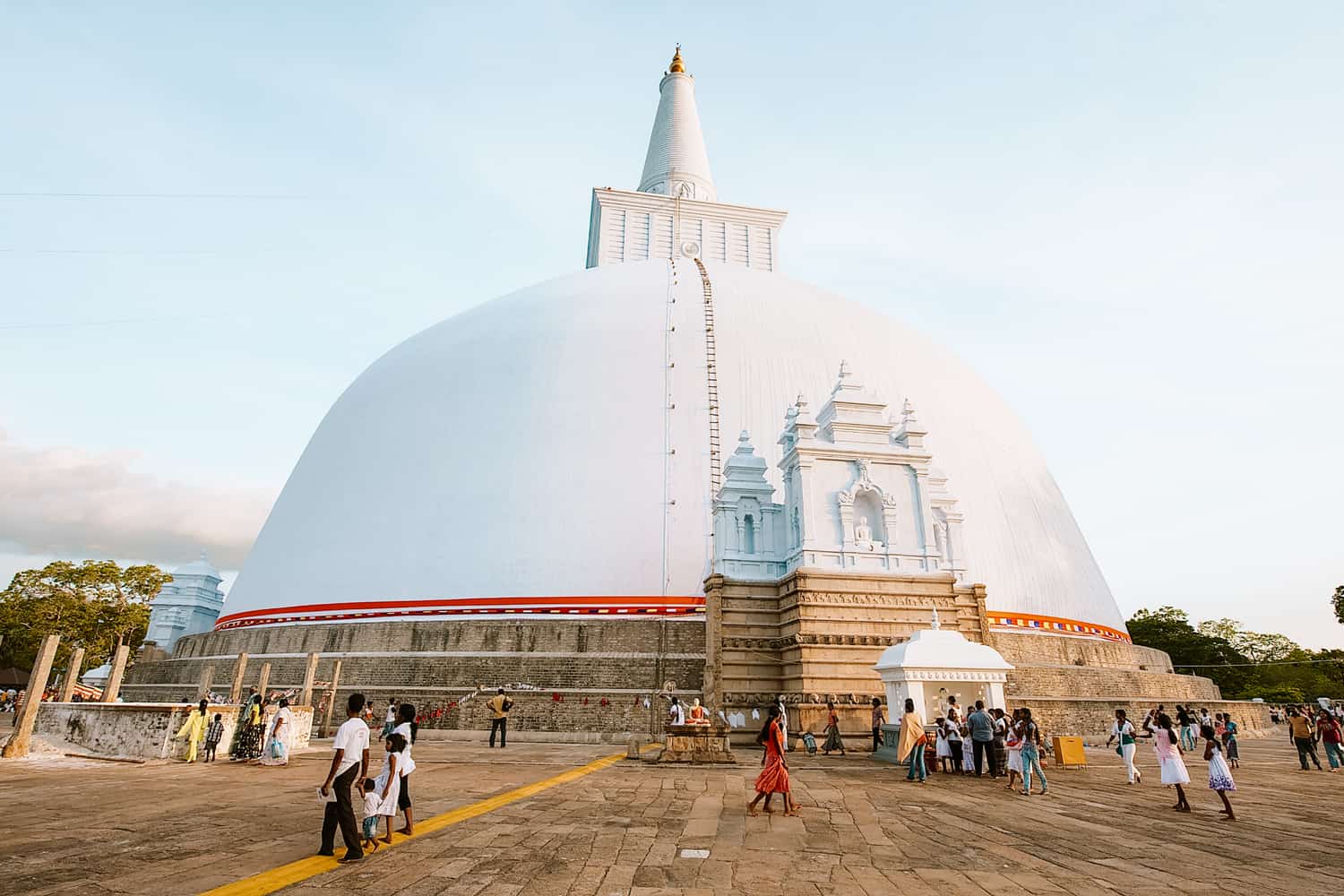If exploring Sri Lankan culture is a priority of your Sri Lanka holiday, make sure to visit Anuradhapura ancient city during your Sri Lanka trip. Established in the 4th century BC, the first kingdom of Sri Lanka, Anuradhapura bears evidence to the great civilization that existed on the island more than 2000 years ago.
Due to its great historical and archaeological significance, the city was declared a UNESCO site in 1982. Anuradhapura is also the birthplace of Buddhism in Sri Lanka and is a popular destination among Buddhist pilgrims, both local and international.
Each tourist attraction of Anuradhapura is backed by a unique historical account that highlights the religious beliefs and technological achievements of the island’s past inhabitants. Within its boundaries, our forefathers’ engineering, architectural, irrigational and hydraulic acumen is immortalized. And these are the very reasons why this ancient royal capital is well worth a visit.
Written in consultation with one of the most knowledgeable and experienced tour guides at Travellers Isle, Mr. Manjula Jayarathne, this article details all the key tourist places in Anuradhapura.
Frequently Asked Questions (FAQs)
Before we dive into the nitty-gritty details of Anuradhapura ancient city, I thought of answering a few practical questions related to tours in Anuradhapura.
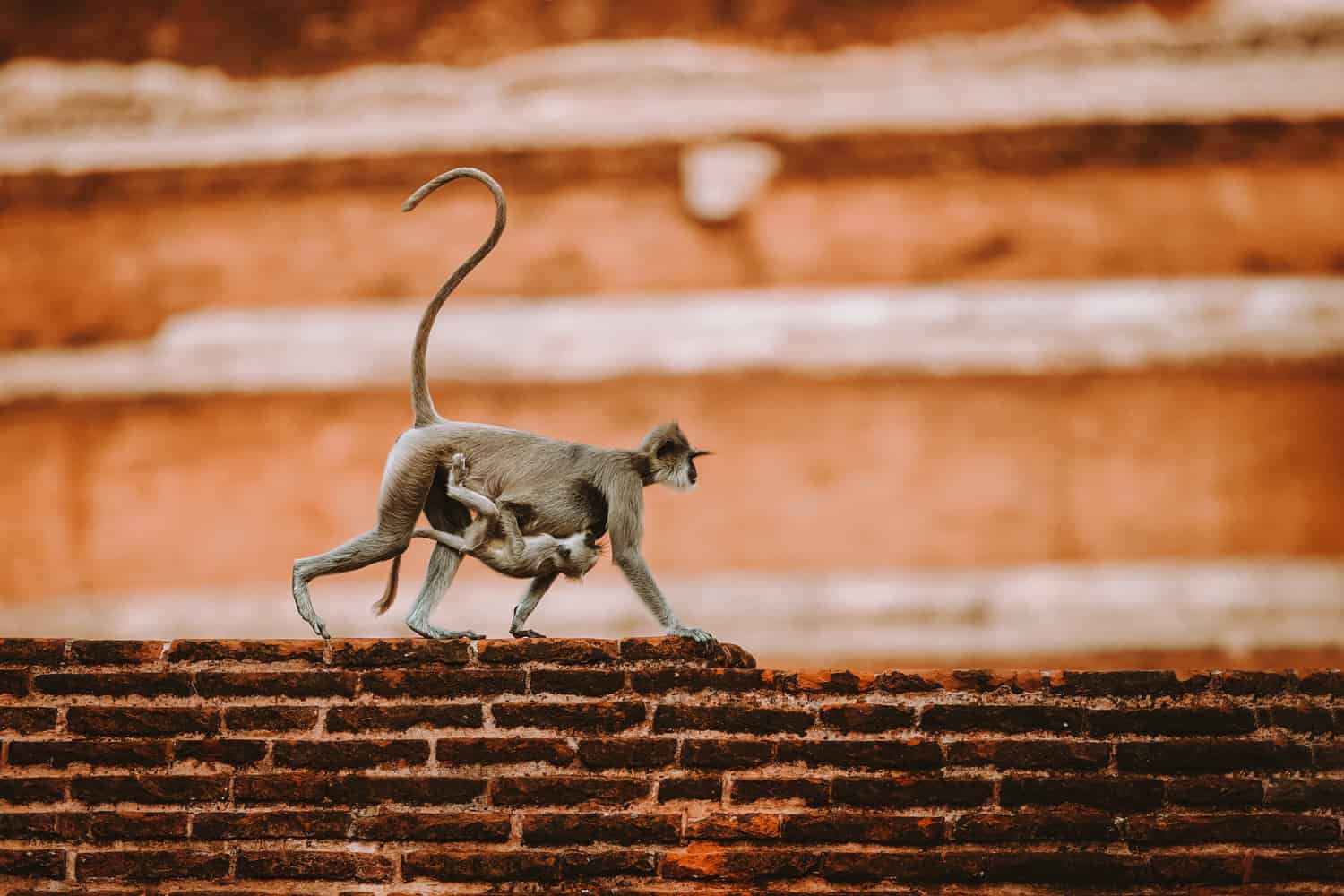
1. How long should I spend in Anuradhapura?
There are many breathtaking historical sites that you can visit in Anuradhapura, and to do justice to them all, we recommend that you spend 1 to 2 nights here. However, if you feel like your itinerary is already crowded, you have the option of visiting this city as a day tour from Sigiriya or Dambulla.
2. How does Anuradhapura fit into a Sri Lanka itinerary?
There are many ways to kickstart a Sri Lankan travel experience; a 4–5-hour drive from the airport to Anuradhapura is not one of them.
So, in the Travellers Isle itineraries, Anuradhapura does not feature as the first stop.
When we plan itineraries for our guests, Anuradhapura is usually placed after locations such as Negombo, Colombo, Jaffna, Trincomalee, Dambulla, or Sigiriya. Browsing our itineraries will help you understand how Anuradhapura can fit into your journey around Sri Lanka.

Would you like a Sri Lanka trip like Beatriz's?
We had the pleasure of assisting Beatriz's family on their two-week holiday in Sri Lanka, and they absolutely loved it. Would you also like a hassle-free family holiday? Please drop us a message specifying your requirements, and we will get back to you with a tailor-made Sri Lanka tour package within 24 hours.

Would you like a Sri Lanka trip like Beatriz's?
We had the pleasure of assisting Beatriz's family on their two-week holiday in Sri Lanka, and they absolutely loved it. Would you also like a hassle-free family holiday? Please drop us a message specifying your requirements, and we will get back to you with a tailor-made Sri Lanka tour package within 24 hours.
3. When is the best time to visit Anuradhapura?
Our tour guide, Manjula suggests that, although there is no particular time of year per se in which to visit Anuradhapura, you might want to remember the following.
Anuradhapura is hottest in the months of March and August. In these months, the evenings are the best time of day to visit the ancient city. This is so for three reasons:
1) March/ August evenings are more pleasant than the hot afternoons, as the environment is cooler and breezier in the evenings.
2) Walking without footwear is easier in the evenings. (Removing shoes is expected of everyone before entering religious sites, which are many in Anuradhapura.) In the hot afternoons, walking barefoot on the heated stone or sand surfaces would be difficult.
3) Locals visit the Buddhist temples and perform rituals in the evenings. If you want to witness the locals performing Buddhist rituals, the best time to explore Anuradhapura is the evening.
In November and December, the weather in Anuradhapura is rainy. On such days, the city is best visited in the morning. There are three reasons for this:
1) It tends to be less rainy in the mornings in Anuradhapura in November and December compared to the evenings there.
2) Walking barefoot would not be difficult in these cooler months compared to March, August, etc.
3) The rain does not discourage local Buddhist pilgrims from engaging in their religious observances. In fact, in December, many Sri Lankans visit the city due to it being a holiday month. However, they visit the sites in the mornings, to avoid the evening rains.
So, in the rainy season, mornings are the ideal time to experience Anuradhapura.
4. What should I wear to religious and historical sites?
Everyone visiting the religious sites in Anuradhapura is required to cover their shoulders and wear clothing that reaches below the knee. White is also the most suitable colour to wear to such places.
Hats will also come in handy and shield you from the hot sun in the afternoons, but should be removed before entering religious sites. More open footwear is suggested in the tropical climate; however, socks may come in useful, especially if required to walk on hot sand/ stone.
5. What is the best way to get around Anuradhapura?
In my opinion, the best way to explore Anuradhapura is by bicycles. It is not only more convenient compared to travelling by foot, but also a great way to enjoy the rural life of Anuradhapura.
A bike tour along the green-fringed roads in and around Anuradhapura will help you observe the locals as they go about their daily business. You will be able to observe planting and harvesting in the fields, fishing in the near-by reservoirs and canals, and locals collecting flowers from the reservoirs, flowers which will be placed as offerings in the ancient temples.
16 Tourist Places in Anuradhapura
According to historians and archaeologists, ancient Anuradhapura was a well-developed and planned city.
At the city’s heart was the citadel or inner city (called Athul Nuwara in Sinhalese). Surrounding the inner city were monastery complexes, which also functioned as Buddhist universities. Within these monastery complexes were stupas which are dome shaped structures built enshrining valuable items such as relics of the Buddha. These complexes were fringed with paddy fields which were irrigated by the nearby man-made reservoirs that formed the outer most circle of Anuradhapura.
Most of the buildings of this impressive royal city were destroyed during the Chola invasions. However, you can still see the ruins of Maha Vihara, Abhayagiri, and Jethawanarama monastery complexes during a tour in Anuradhapura.
The Maha Vihara monastery complex
The Maha Vihara of ancient Anuradhapura was a Theravada Buddhist monastery complex. The stupas of this complex were restored before Anuradhapura was named a UNESCO site. According to historical records, the monastery was established by King Devanampiyatissa in the 3rd century BC. Within the ruins of this complex today are the Sri Maha Bodhiya, Thuparamaya, Lowamahapaya, Ruwanweliseya, and Mirisawetiya.
1. Sri Maha Bodhiya
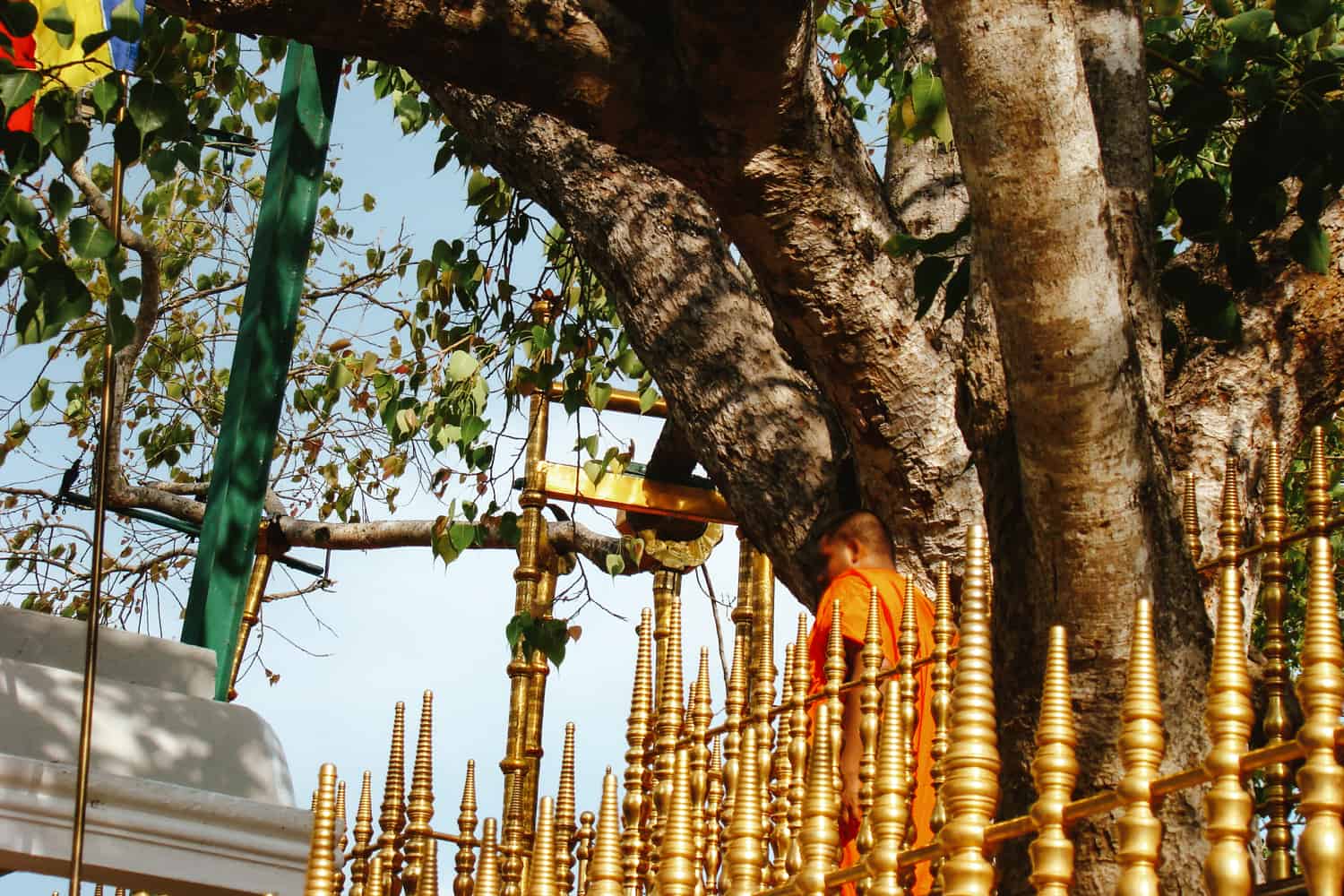
The Sri Maha Bodhiya is the world’s oldest tree that has a written history. It was planted in the Mahamevna Park by King Devanampiyatissa in the 3rd century BC. It is believed that this tree originated from a sapling of the Bo tree under which the Buddha attained Enlightenment. Given its history, this tree is sacred to not only the Buddhists of Sri Lanka, but to devotees from all over the globe. For this reason, it is placed among the Eight Sacred Places of the Anuradhapura city.
2. The Ruwanweliseya Stupa
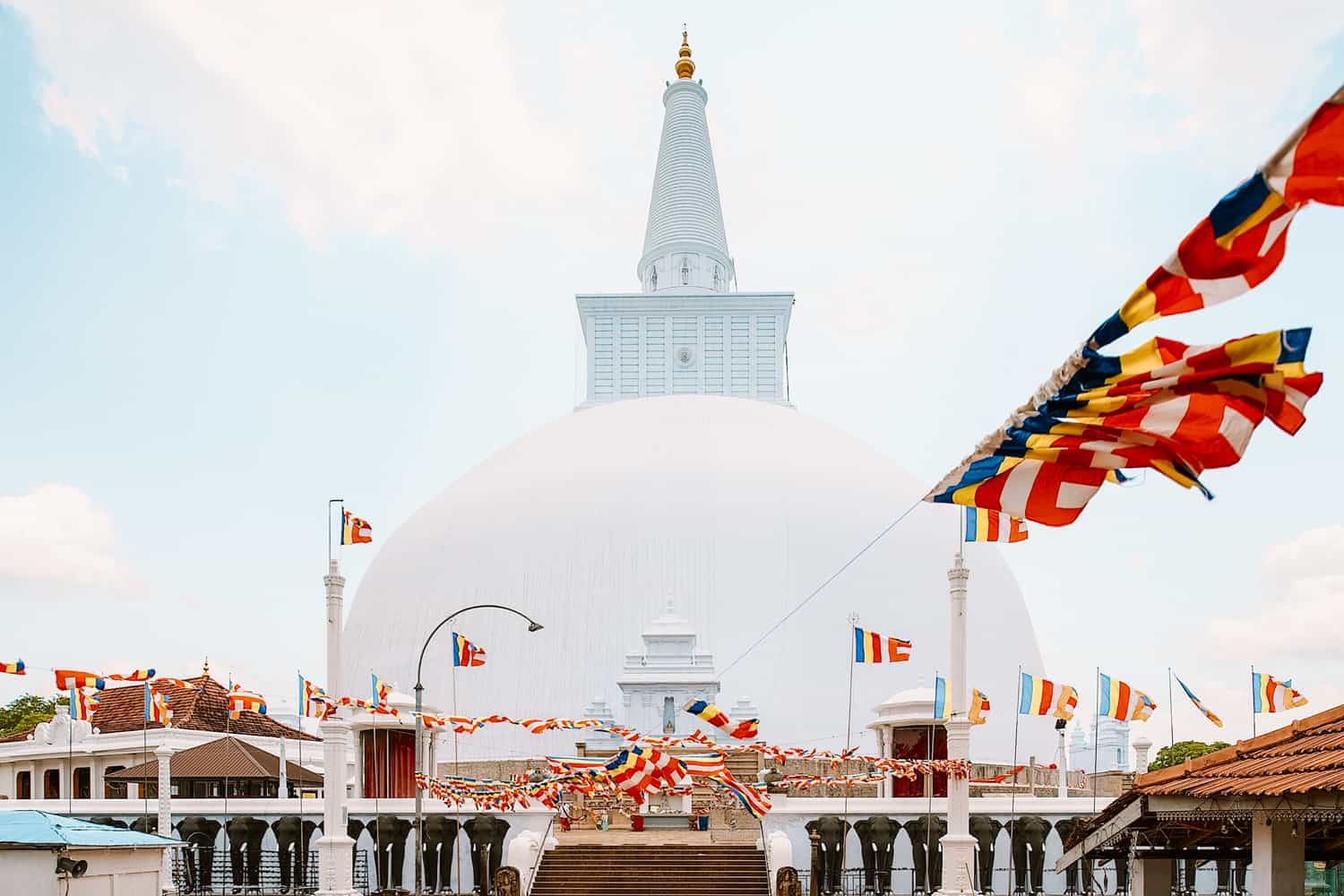
When in Anuradhapura, one must visit the Ruwanweliseya stupa. As a part of the ancient Maha Vihara monastery complex, Ruwanweliseya is a popular site of veneration among Buddhists today. It is also one of Anuradhapura’s Eight Sacred Sites. One of its many significances is that it holds within it the largest collection of relics of the Buddha.
King Dutugemunu, a monarch treated as a national hero for unifying Sri Lanka, is credited with commencing the construction of this stupa in the 2nd century BC. Historians believe that, at the time the stupa was built, it may have been the tallest stupa in the world.
The diameter at the base of the Ruwanweliseya is 289 ft. At the cardinal points of the stupa, you will be able to see four ornate stone frontispieces. Surrounding the stupa is a stone-paved terrace. At the four corners of this terrace are four miniature stupas. On the terrace there is also an image house which shelters statues of past Buddhas as well as the Buddha to be. You can also see ancient stone inscriptions, stone pillars and statues of ancient kings.
The stupa was renovated in the early 20th century. Today, Sri Lankan Buddhist rituals including offering of flowers and chanting of sacred Buddhist verses can be observed in the premises of the Ruwanweliseya.
3. The Mirisawetiya Stupa
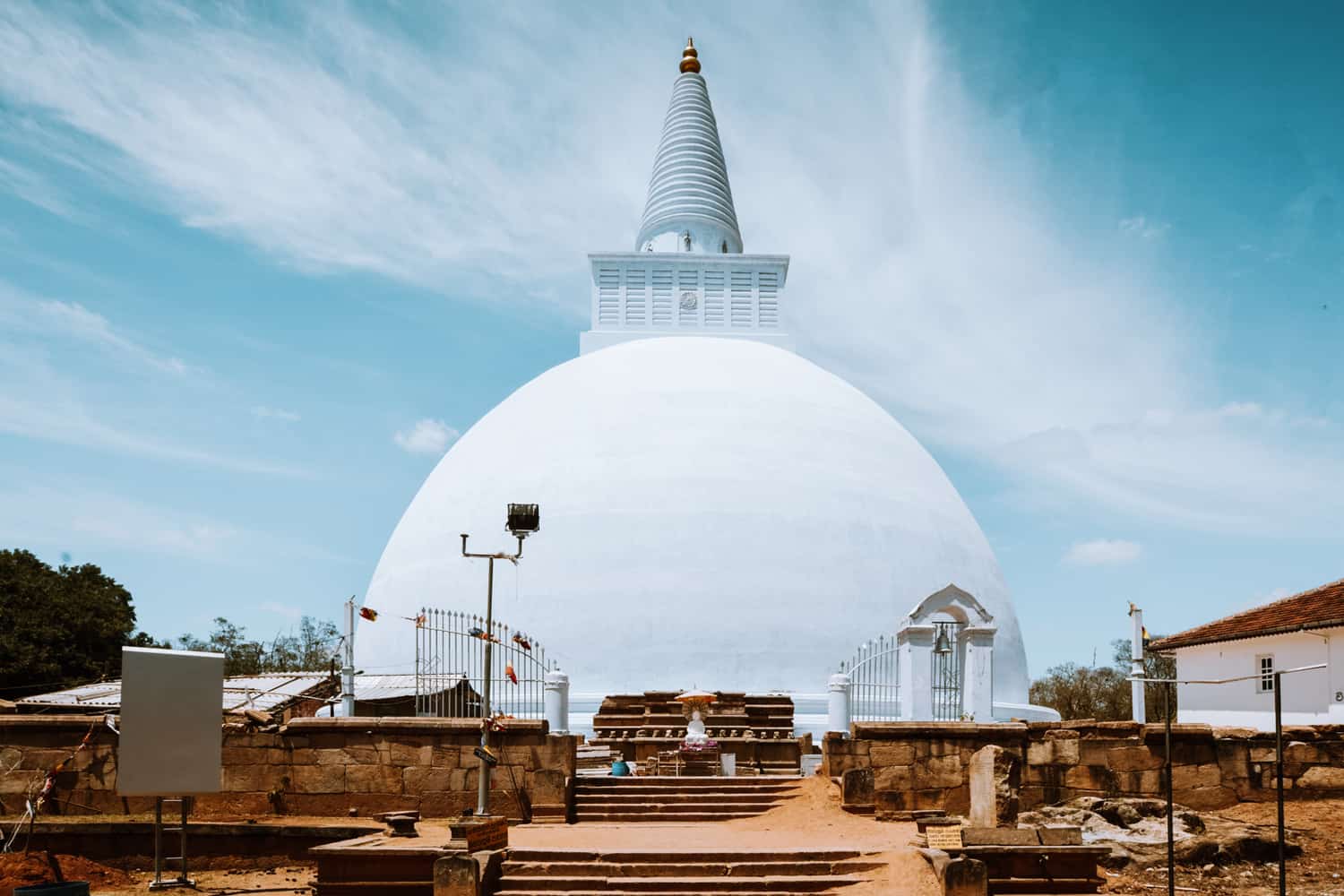
The Mirisawetiya stupa was also built by King Dutugemunu. It was built earlier than the Ruwanwelisaya and has a diameter of 108 ft at its base.
There are several stories surrounding the origins of this stupa. One of them is that King Dutugemunu placed within its dome his royal scepter. This stupa is among the six stupas that belong to the Eight Sacred Places of Anuradhapura.
4. The Thuparamaya Stupa
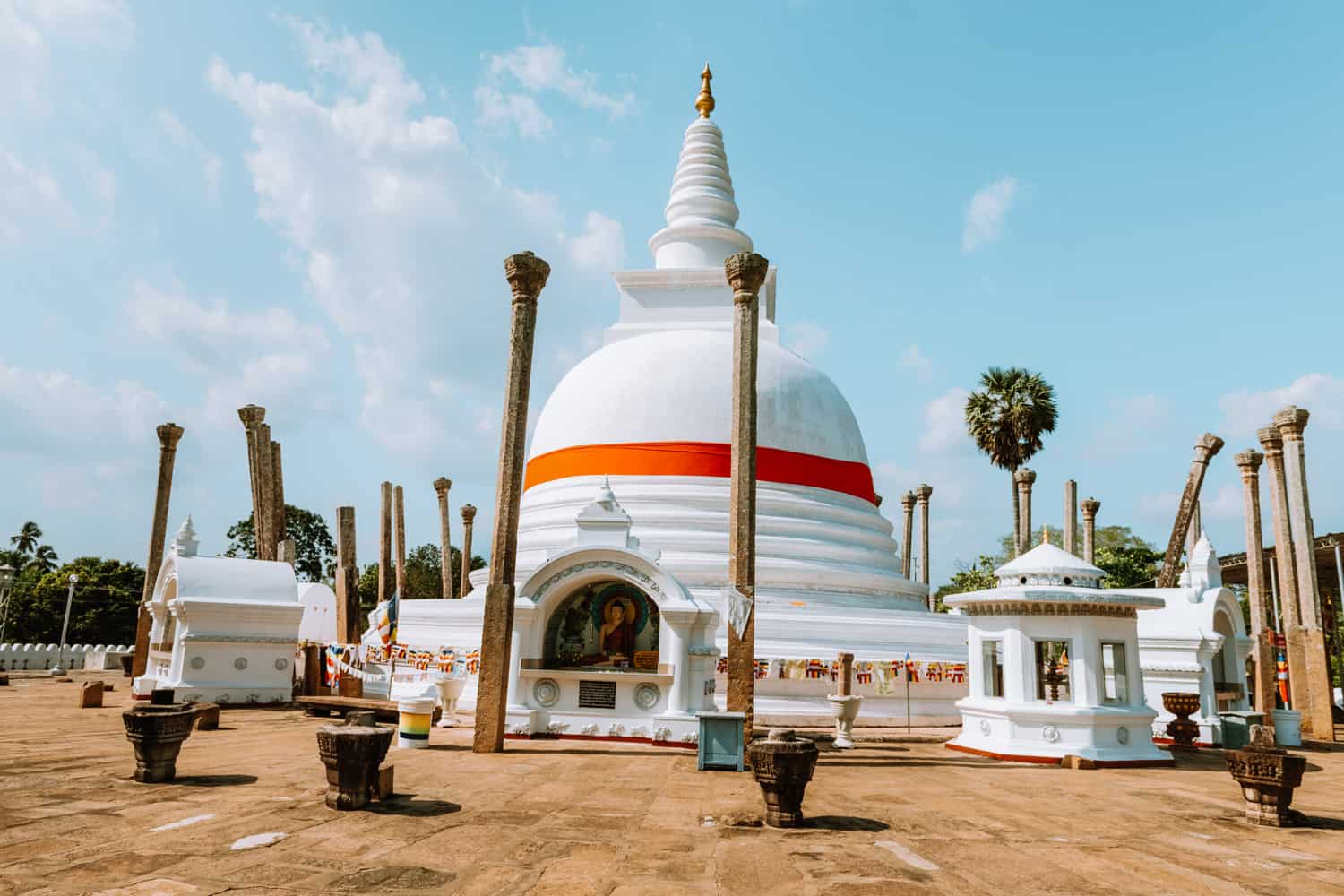
While the Ruwanwelisaya is famous for its size and religious significance, the Thuparamaya stupa holds a special place as it is considered to be the first stupa to be built in Sri Lanka. It was built within the Mahamevna Park, in the 3rd century BC, by King Devanampiyatissa, during whose reign Buddhism was introduced to Sri Lanka. It is another of the Eight Sacred Sites of the city.
This bell-shaped stupa is surrounded by stone columns which may have supported a roofing structure that sheltered the stupa in the past. The diameter at the base of this structure is 59 ft. The stupa had been destroyed and restored multiple times in the past. What can be seen today is the 1984 reconstruction of it.
5. Lowamahapaya
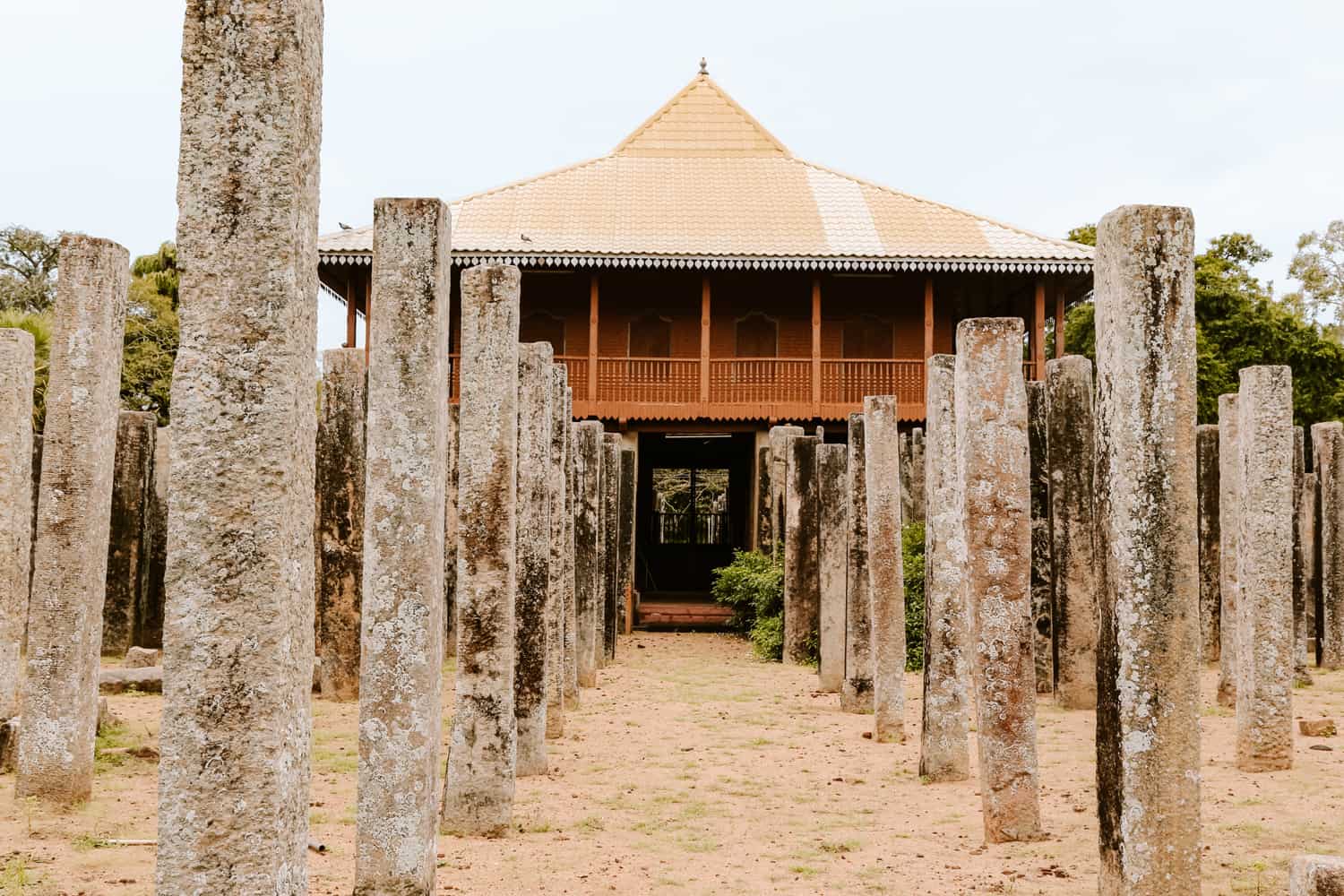
Another of the Eight Sacred Sites of Anuradhapura, the Lowamahapaya, also called the Brazen Palace, was a 9-storey construction built during King Dutugemunu's reign in the 2nd century BC. The edifice was used as a Buddhist monks' hostel, a conference hall, and an image house. It is believed to have been the tallest building in the island from the 2nd century BC to 10th century AD. More than 2000 years after its construction, 1,600 stone columns that supported this once majestic building still stand tall today.
The Abhayagiri Monastery Complex
One of the three main monastery complexes in Anuradhapura was the Abhayagiri monastery. In the past, this monastery was also a world-famous university in which as many as 5,000 Buddhist monks lived and studied Theravada and Mahayana Buddhism. Established by King Valagamba in the 2nd century BC, today it is a 200-hectare historical site.
One of the many significances of the Abhayagiri monastery is that it was once home to the Sacred Tooth of the Lord Buddha. In the 5th century, the Chinese monk Fa-Hsien visited Abhayagiriya and wrote of the annual festival organized to honour the Tooth Relic. These are the origins of the Kandy Perahera, still in practice today.
Within the Abhayagiriya monastery complex are the Abhayagiriya Stupa, Lankaramaya, Samadhi Buddha Statue, the Twin Ponds (Kuttan Pokuna), and the Elephant Pond (Ath Pokuna). You can also see the moonstone, carvings, decorations and a museum within the monastery complex.
6. The Abhayagiriya stupa

Built in the reign of King Valagamba in the 1st century BC, this stupa stands at 73 m in height today. As a part of the UNESCO heritage site, the stupa was carefully conserved and restored using no cement and a minimum number of new bricks introduced. The conservation process began in 1981. It is also one of the Eight Sacred Sites, or Atamasthanaya, of the city.
Surrounding this massive brick edifice are the ruins of a conference hall and a hostel that provided shelter to monks. In addition, there are the remnants of an alms hall.
7. The Lankaramaya Stupa
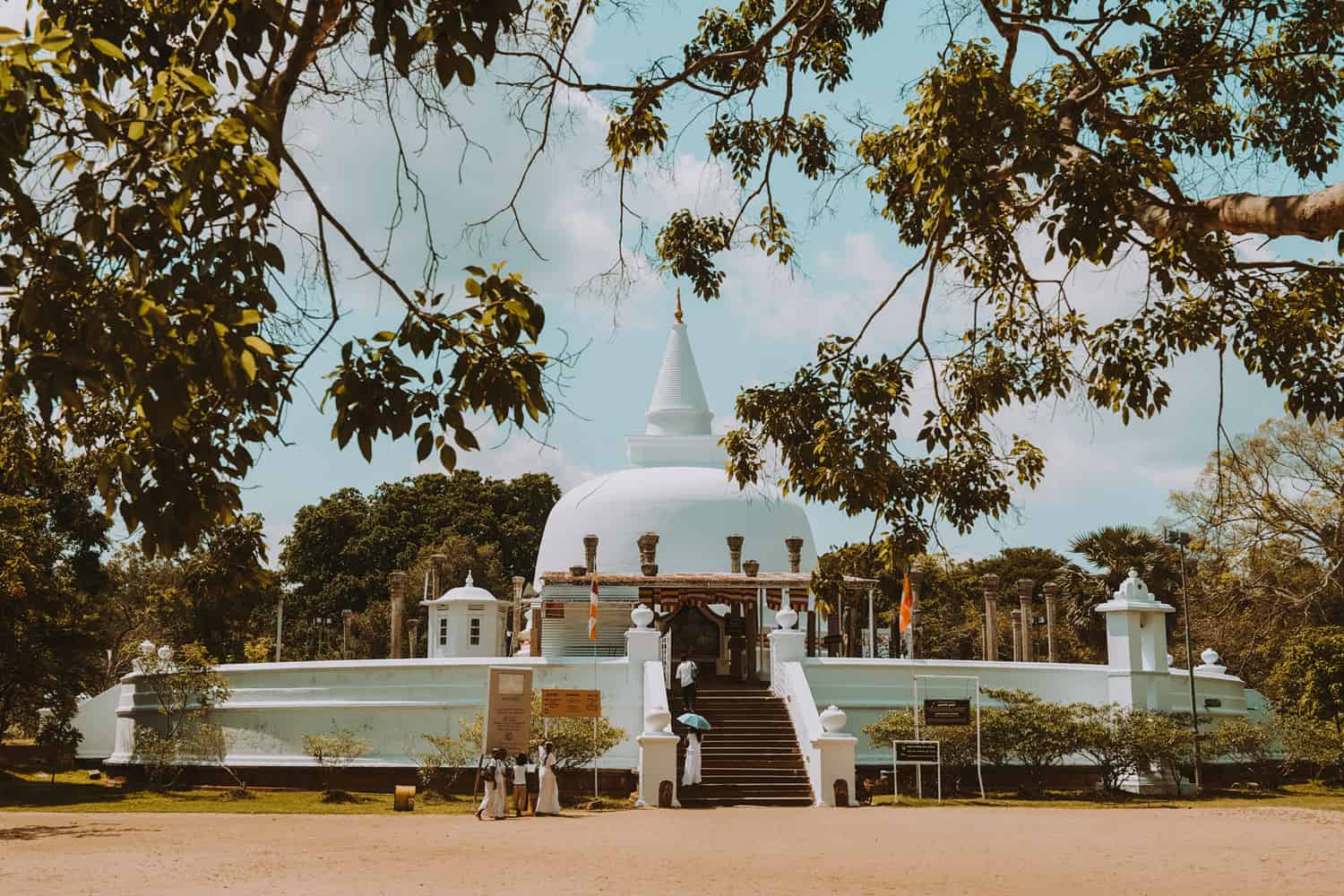
The smallest of the stupas in Anuradhapura, the Lankaramaya stupa is surrounded by carved stone pillars and a stone-paved terrace. According to historical records, this stupa was constructed by King Valagamba in memory of one of his queens, Soma Devi, who sacrificed her life to save the king. Today, it is among the Eight Sacred Sites in Anuradhapura.
8. The Samadhi Statue
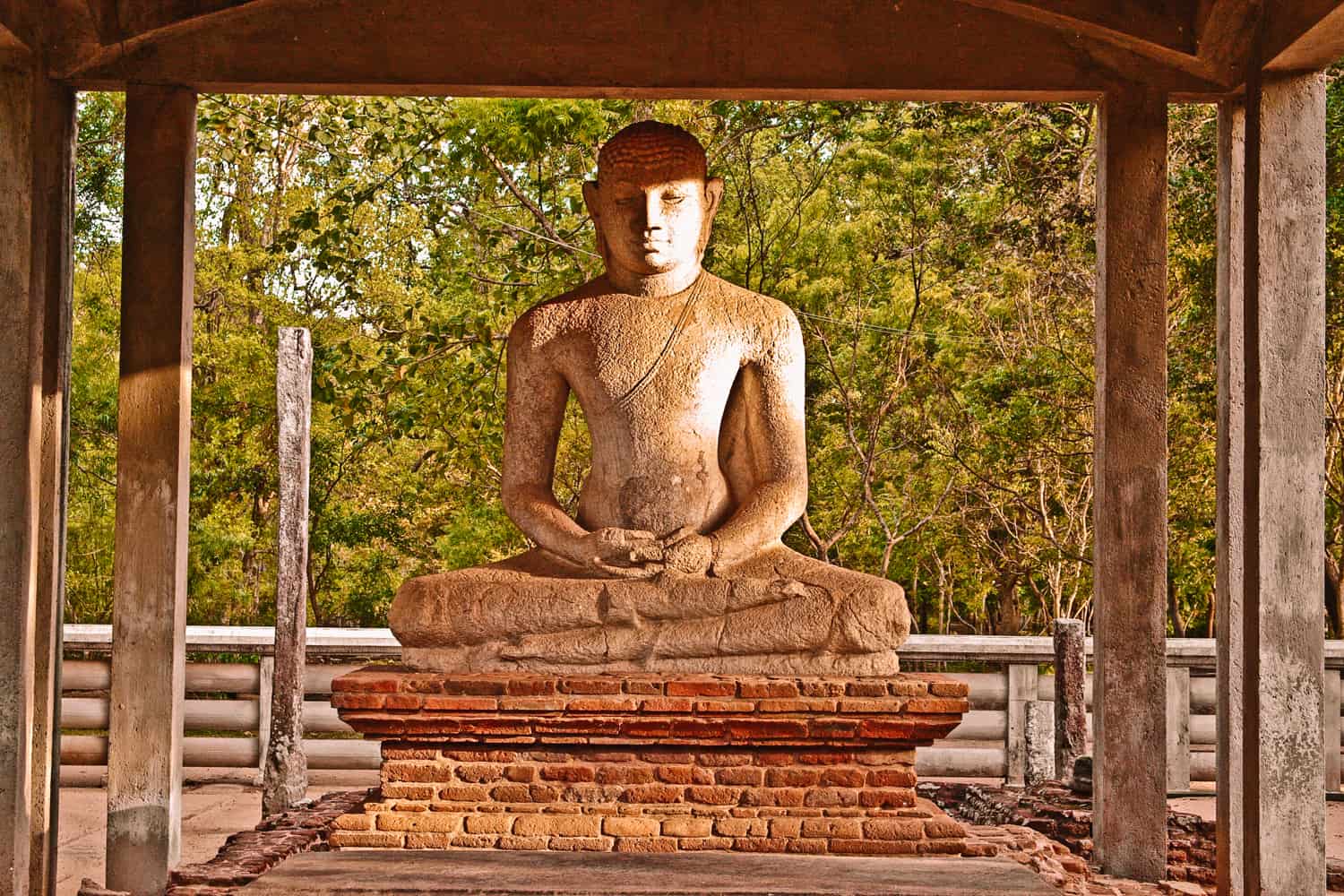
The Samadhi Buddha Statue is a product of ancient sculptors who skillfully etched the serene expression of the Lord Buddha on granite stone. Located within the Mahamevna park in Anuradhapura, this 7-foot marvel depicts the Buddha in a cross-legged meditating position. Both the calmness of the surrounding and the humane facial expression of the stone statue have a soothing effect on visitors. The Samadhi Statue is one of the Eight Sacred Sites in Anuradhapura and is no doubt among the most famous symbols of Sinhala Buddhist culture.
9. Moonstone
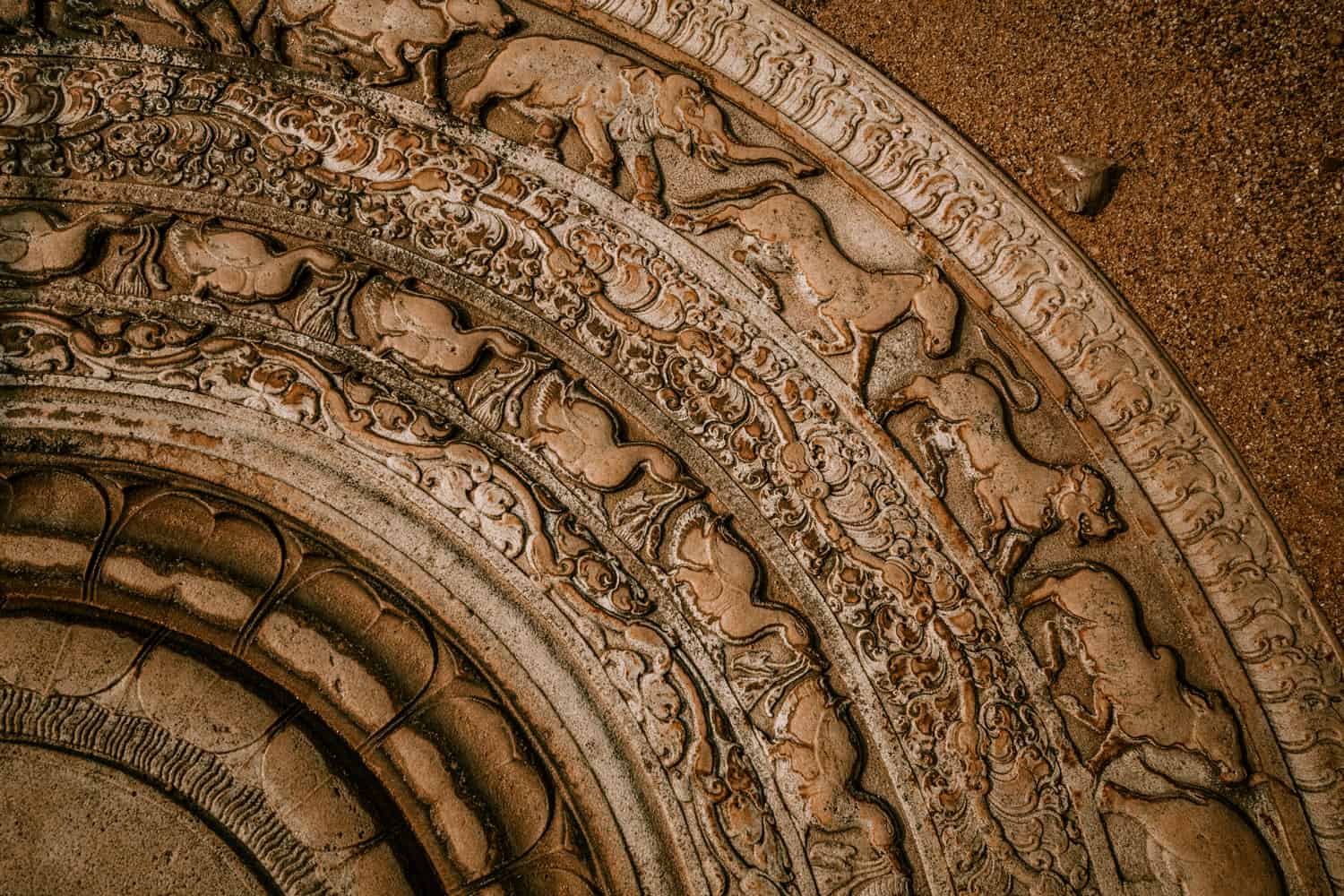
Like the Samadhi Buddha Statue, ornamented moonstones too are important symbols of the Buddhist culture in Sri Lanka. Some moonstones are plain, while others are delicately carved.
In Anuradhapura, a well-preserved and intricately decorated moonstone can be seen at the entrance to the ruins of the accommodation facilities of Abhayagiri monks. In the past, this building was misnamed as the Queen’s Palace. In later years, historians re-identified this building as a monks’ residential complex.
This moonstone constitutes concentric half-circles carved out of stone. While the smallest semi-circle is a part of a lotus, the bigger ones include intricate carvings of animals, swans, creepers and fire. Historians interpret these carved elements in each semi-circle to be aligned with the teachings of the Buddha.
10. The Twin Ponds
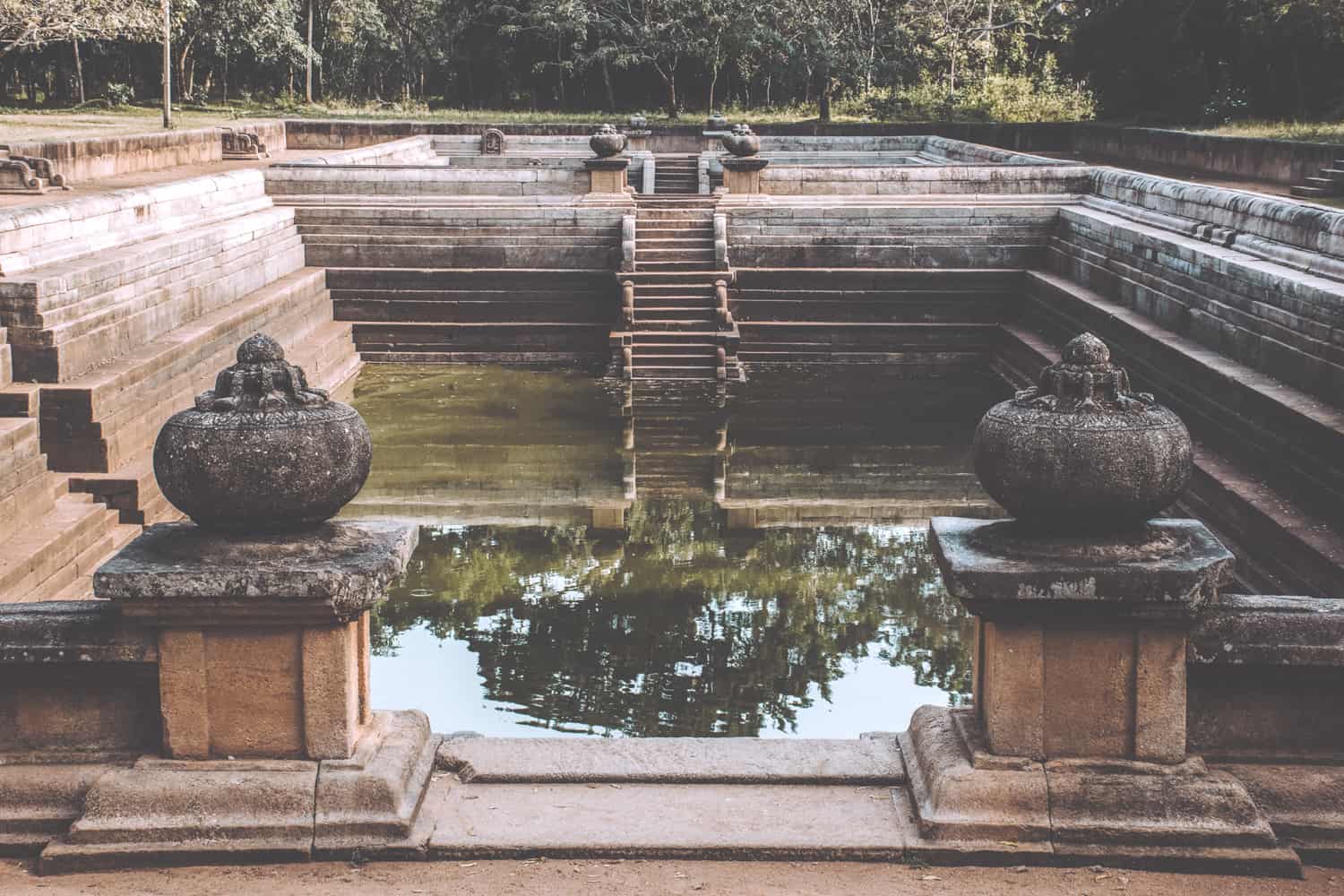
Complete with a filtering system and underground pipelines, the Twin Ponds are yet another engineering marvel from the Anuradhapura period. Believed to have been constructed during the reign of King Aggabodhi I in the 6th century AD, this pair of ponds bear testimony to the hydraulic knowledge of ancient Sri Lankans.
At first glance, both ponds appear to be identical. But they are of different sizes and were supposedly constructed at different times. They are lined with horizontally placed stones pillars with intricately carved stone staircases leading to the water. At the top of each staircase can be seen two punkalasas which are oval shaped structures that symbolize abundance in Sinhala culture.
11. The Elephant Pond
Apart from the Twin Ponds, the Elephant Pond too displays the advanced irrigation and hydraulic technology of the ancient islanders. It is larger than the Twin Ponds and is believed to have been used by the Abhayagiri monks. Built 2000 years ago, this Pond has the capacity of about 6 Olympic swimming pools. Water from two neighbouring manmade reservoirs is conducted into this pond along an ancient drainage system.
Jethawanarama Monastery Complex
The Jethawanarama monastery complex was influenced by both Mahayana and Theravada Buddhism. It was established by King Mahasena, who was primarily a follower of Mahayana Buddhism.
12. The Jethawanaramaya Stupa
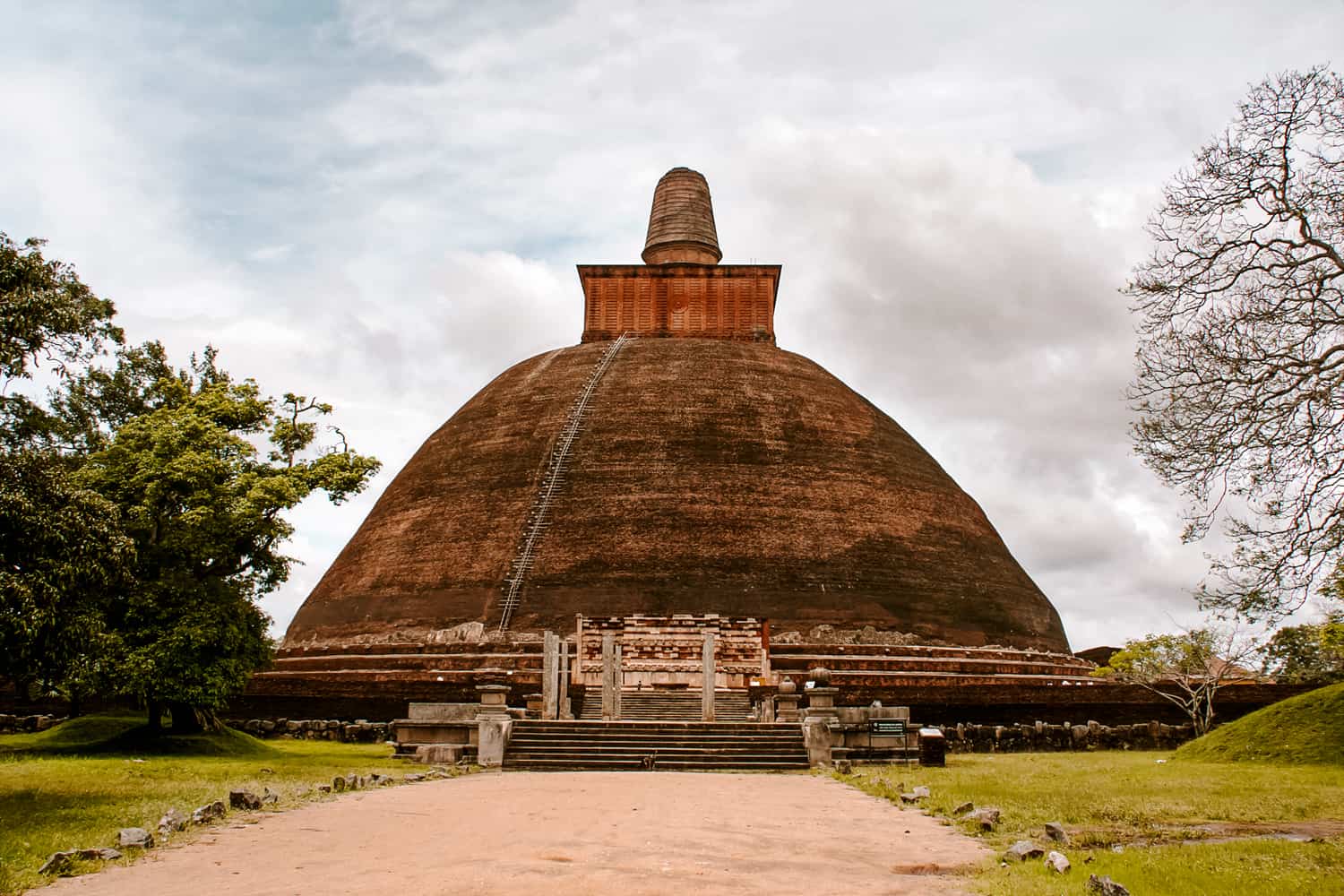
One of the key historical sites belonging to this monastery complex is the massive Jethawanaramaya stupa. This stupa too is among the Eight Sacred Places of Anuradhapura. Built in the 3rd century AD, this stupa is a reliquary monument that shelters a remnant of the Lord Buddha’s belt. The stupa is yet another engineering and architectural marvel from the Anuradhapura period.
This stupa is thought to have been the world’s largest brick structure of that era and the third largest construction in the world (the first two being two Egyptian pyramids). Historians estimate that about 93 million bricks were used for the construction of this site.
On the terrace surrounding the monument, you can see stone carvings of a seven headed cobra and guard stones. You can visit a relatively modern shrine room on the terrace surrounding the stupa, which houses statues of the Buddha and some Hindu deities.
The Citadel: The Heart of Anuradhapura
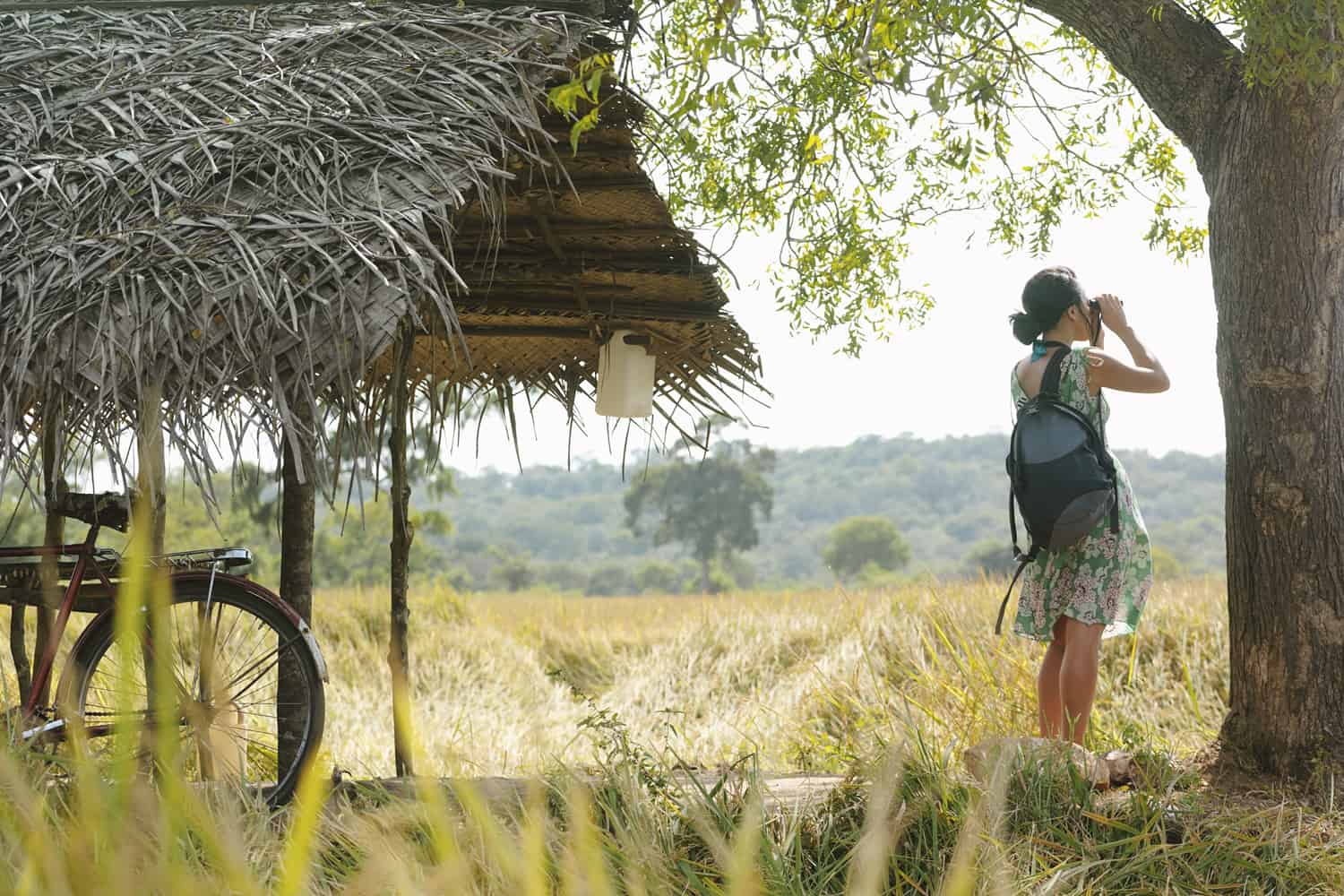
At the center of the Anuradhapura city is the Citadel, also known as the Inner city. Within the boundaries of the Citadel, you can visit the ruins of Sri Lanka’s first Temple of the Sacred Tooth, the Mahapalee Alms-Hall, the Wijayaba Royal Palace, and the Salgaswatte Archeological site.
Although I believe the sites in the Inner City are must see tourist places in Anuradhapura, most tours do not cover them due to time constraints. This made it a bit difficult to find good photos of these sites. If you visit these sites during your tour in Anuradhapura, please send us some photos. It will help us to make this article even more useful.
13. The First Temple of the Sacred Tooth
The Inner City is home to the Dalada Ge or the first Temple of the Sacred Tooth Relic. The Sacred Tooth, once it was brought to the island during King Kithsiri Mevan’s reign in the 4th century AD, was sheltered within the walls of this building.
14. Mahapalee Alms-Hall
The Mahapalee Alms-Hall is believed to have been a refectory belonging to the Abhayagiriya monastery. According to historians, it was built by King Devanampiyatissa in the 3rd century AD. At this site can be seen a rice trough made of stone and a well which may have been used to supply water to the refectory.
15. The Salgaswatte Archeological site
For lovers of archaeology and historical artefacts, the Salgaswatte archaeological site is a go-to place. Located close to the Dalada Ge, this 100 m x 75 ft pit has produced evidence of a city that existed in the Inner City in 500 BC. The archaeological research teams currently working on this site have uncovered horse teeth, gold jewelry, a guard stone, underground drains and brick walls.
16. The Royal Palace of King Vijayabahu I
This palace is believed to have been built as a temporary palace by King Vijayabahu I in 1055 AD. Today, carved guard stones, a stone staircase and the remnants of ancient wall art can be seen at this historical site.
In the historical chronicles, King Vijayabahu is credited with defeating the Indian invaders called Cholas and re-establishing Sri Lankan monarchy. After his coronation, he decided to move Sri Lanka’s capital from Anuradhapura to Pollonaruwa.
Summary
Holding within itself the evidence of the knowledge and skills of the ancients, Anuradhapura is no doubt a portal to the past. The curves of its intricate rock carvings and the massive shadows cast by its gigantic brick monuments bear testimony to the artistic and engineering skills of not just Sri Lankans but of humanity.
I hope this article, "Must see tourist places in Anuradhapura" will inspire you to visit Anuradhapura and discover its many treasures. Please leave a comment, if you have any questions. If you would like us to organize your Sri Lanka trip, please drop us a message. We at Travellers Isle are looking forward to hearing from you.
If you are wondering what else Sri Lanka has to offer, I invite you to read my article, "Best hikes in Sri Lanka", to learn another facet of the beautiful island nation of Sri Lanka.
Happy travels!

